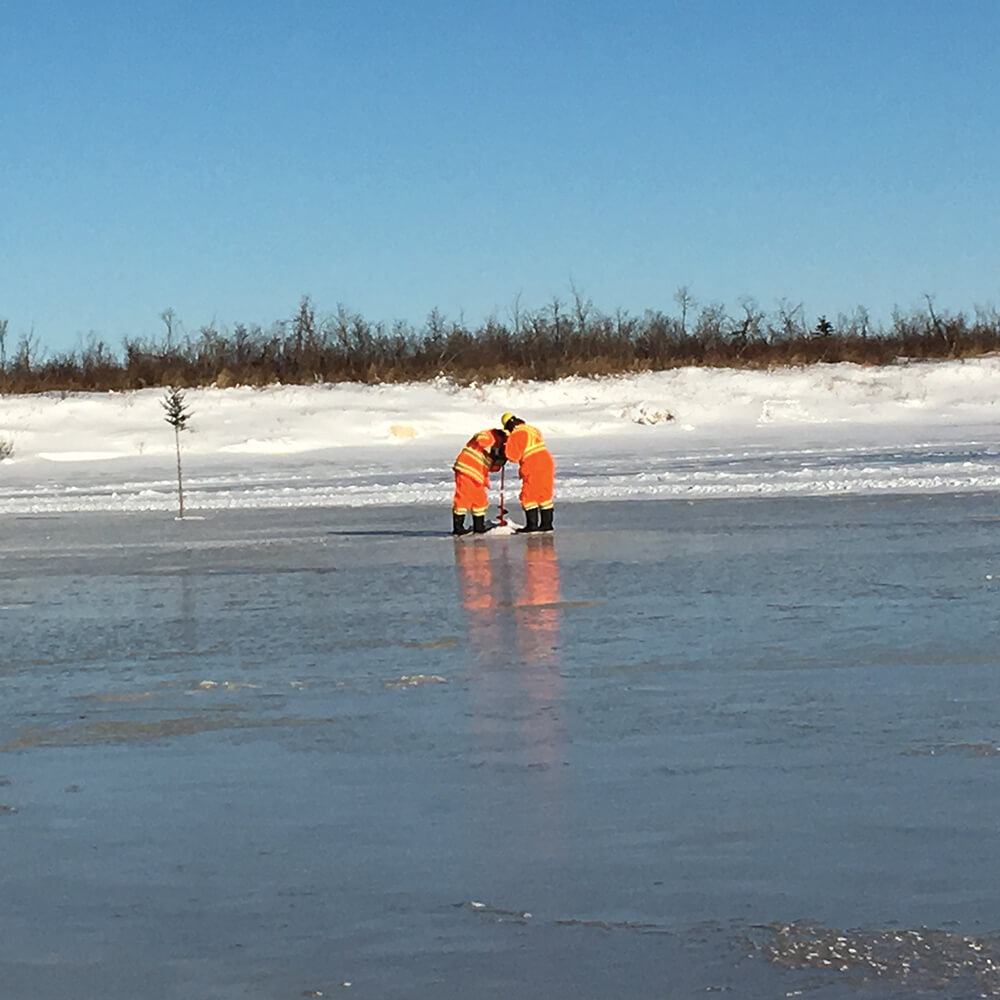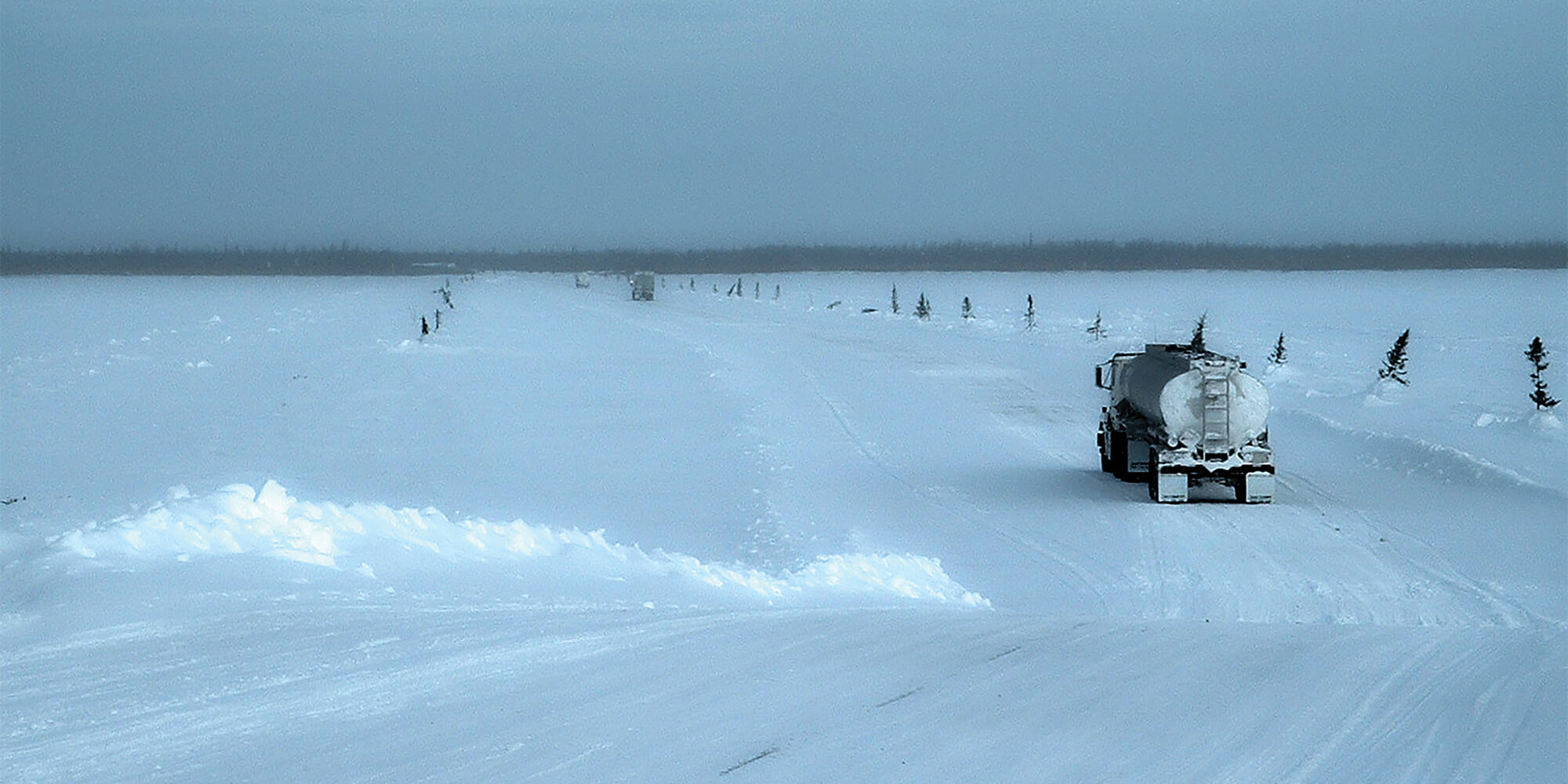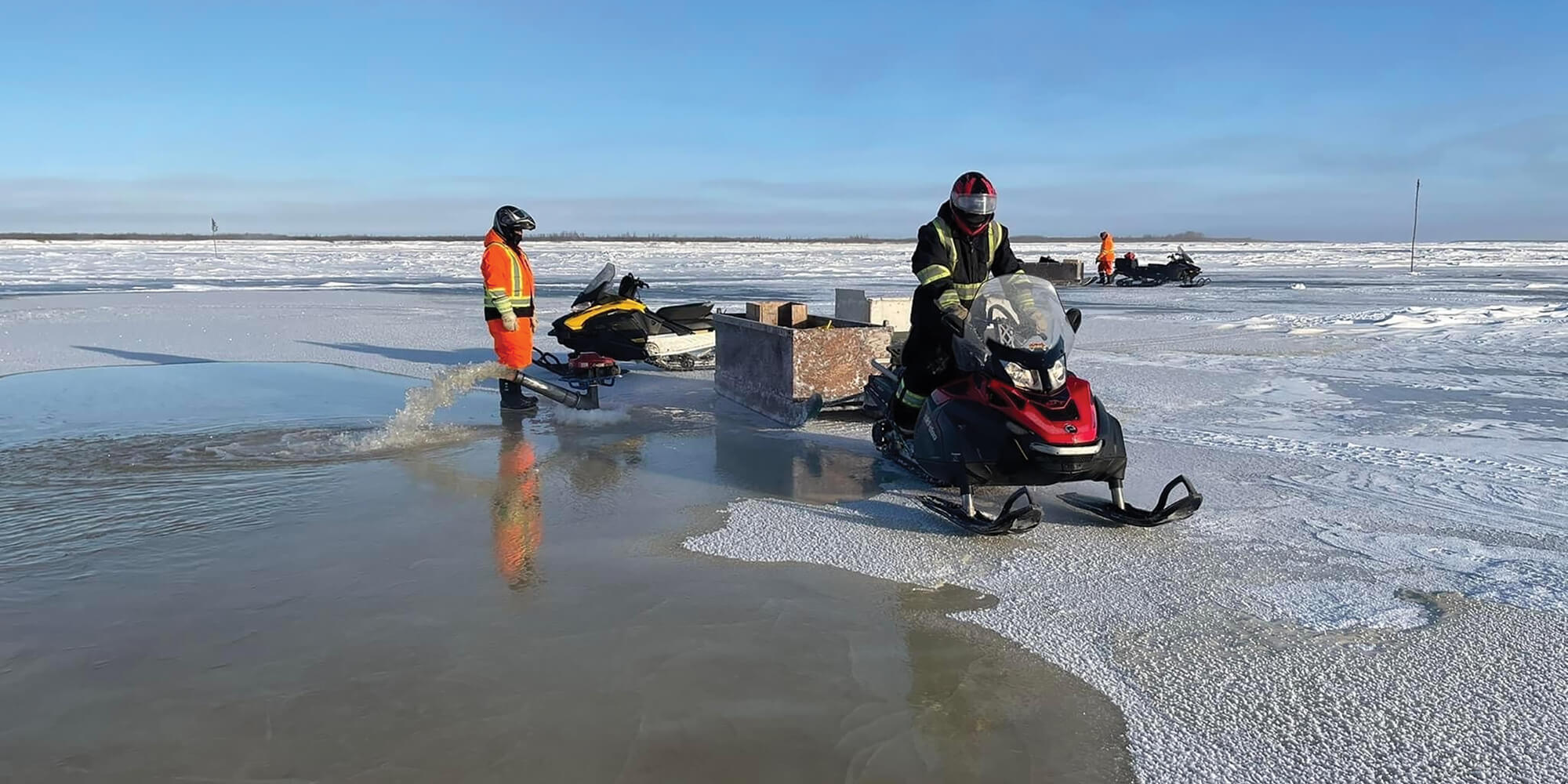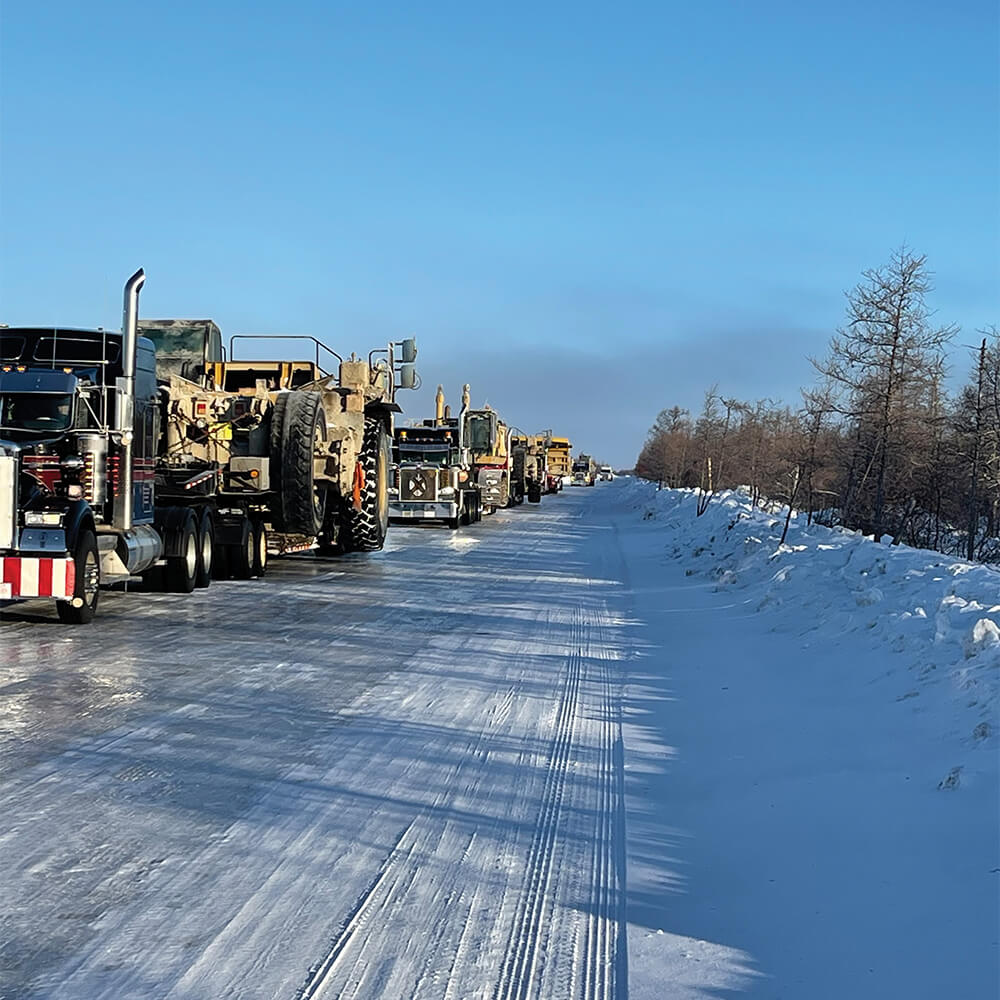August 1, 2023
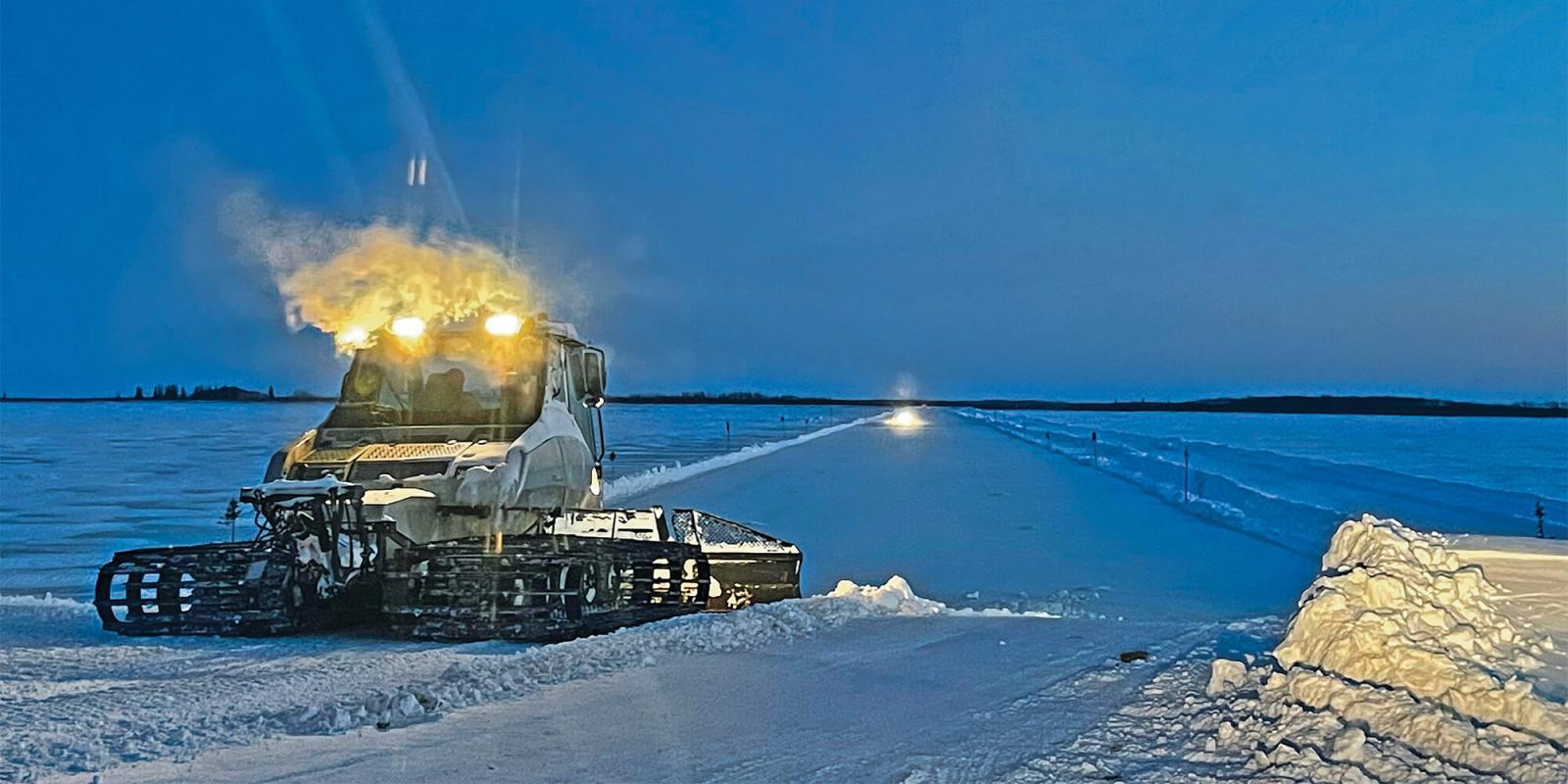
Slick conditions
When an ice road is the desired result
BY KARINA SINCLAIR
When tasked with plowing roadways in most of Canada, minimizing ice is a basic expectation for snow and ice management professionals. But what if an icy road is the goal? Temporary winter roads and ice roads are lifelines for northern communities. Of course, building and maintaining them is a completely different matter compared to all-season roads those of us in temperate locales are used to.
A winter road is a temporary transportation route that runs over fr ozen land and water. The winter road could also pass over peatlands or muskeg swamp terrain and these land-based portions are known as portage. An ice road is built on floating frozen stretches of lakes, rivers, and parts of the sea, and incorporates ice bridges to connect to the shoreline. In all cases, the ice must be thick enough to support the weight of vehicles and cargo, which requires the expertise of engineers, patrollers, flooders, and snow plow and grader operators.
Connecting Canada’s northern communities
According to the Department of Northern Development, Ontario has the longest winter road network in Canada, stretching 3,200 kilometres. Approximately 24,000 northern Ontarians rely on these ice roads, which are only open for six to 11 weeks a year — from January to the end of March.
Part of that network is the 312-km James Bay Winter Road, which connects three remote Indigenous communities and the Town of Moosonee. This passage is essential for transporting goods to the Indigenous First Nations of Attawapiskat, Fort Albany, and Kashechewan that are otherwise inaccessible the rest of the year (unless a $1,250 round trip plane ticket is in the budget).
Nancy Wood is the president and project manager of Kimesskanemenow LP, the company responsible for all work done on the James Bay Winter Road. The word kimesskanemenow is a Cree word which means “this is our road.” Not only does the winter road connect the remote First Nations communities, it provides seasonal employment. Wood says the purpose is to ensure there is sufficient ice to safely deliver all necessary equipment to the communities, including fuel and construction supplies to build schools, homes, medical centres and stores.
Although it’s not the only winter road in Ontario, the James Bay route does have a particular challenge. “We cross over approximately 58 water crossings, five of which are major tidal rivers,” Wood said. “One of those crossings over the Albany River is 1.6 km and the other is 900 metres. So they’re both pretty large and there is no bridge. It’s just an ice bridge. Since this is a tidal river, they go up and down every day so it’s challenging to make sure the ramps stay suitable.”
Some years, the weather cooperates and makes construction and maintenance of ice roads easier. “The 2021/22 winter road season was amazing,” Wood said. “It was really, really cold in December, and so the muskeg froze really solid. We didn’t get any snow, which acts as an insulator and sometimes prevents it from freezing solid. It was great. We got everything we wanted in that season. We got everything we wanted out. It was fabulous.”
A warmer winter might have Canadians in urban centres cheering, but not so in the remote north. “Last winter [2022/23], it was very warm during the initial construction in December and we got a lot of snow,” Wood lamented. “We had real challenges trying to drive the frost into the muskeg to get it solid enough to have all these big heavy trucks traveling on them.”
An ice formation of epic proportions
So how does such a road even get built? Nature takes the first step. Ice begins to form on northern lakes and rivers in autumn and is considered safe enough to walk on when it is at least 10 cm thick. By 18 cm, the ice can bear snowmobiles and riders. Amphibious tracked vehicles can begin to clear snow from the route at 30 cm. And so long as the ice is generally free from cracks and reaches a minimum thickness of 40 cm, large grooming machines can now complete the process, and plow the route to its full 45 m width. That is roughly the width of a 12-lane permanent highway.
Removing snow from the ice surface helps create thicker ice. This is because of the insulating properties of snow. As snow is pushed to the edges to create snowbanks, the thicker ice in the cleared driving lanes becomes more buoyant than the thinner ice under the snowbanks. This could lead to cracks and bends in the lanes, which have to be monitored and repaired if they extend all the way through the ice.
Local contractors from the served communities are the ones who manage the construction and maintenance. “They’ve been doing it for a long time. These guys that are running these pieces of equipment are amazing,” Wood said. “Just to watch them with the loaders, graders and water trucks is quite fascinating because they really know what they’re doing. They know which areas are going to be problematic and how to deal with it. Every area has their own little tricks.”
The extreme weather conditions and dangerous elements makes it difficult to find workers to fill all the roles. Many of the experienced equipment operators are getting older and Wood said the available workforce is in transition. “Some operators are reluctant to let somebody who has just gotten their heavy equipment operator training to run their $300,000 piece of equipment. So it will continue to be a challenge because a lot of the gentlemen that have been working for years and years are either retiring or have passed away.”
While these are well paid jobs, they are daunting. If a stretch of ice is still too thin, a worker needs to drill holes in the ice, pump water up from below and flood the surface. “I don’t know that I would be really interested in standing outside doing flooding when it’s 35 below for six weeks at a time,” Wood said, adding that in the past year, the crossings needed to be 60 inches (152 cm) thick in order to carry out the heavy equipment from the former De Beers Victor Mine. “That’s a lot of flooding. The natural ice might be 30 inches (76 cm), so we’re flooding that ice to be almost as tall as I am.”
In the throes of snow clearing, permanent roads get scattered with grit, salt, and other liquids meant to prevent ice from accumulating on asphalt. A winter road that spans frozen water and swampland requires a different approach. “We don’t use sand or salt,” Woods said. “If you think about muskeg, it’s very dark, almost black. Once the sun hits the black, it absorbs the heat and it melts really quickly. So a lot of what we’re trying to do once the road is open is cover up the dark spots with snow so the road doesn’t melt prematurely.”
To add to the winter road’s durability, some of the crews use retrofitted milk tankers that spray water to add an ice cap about four centimetres thick. “And then, to make it less slippery, especially on sharp corners, we scarify it. We’ve got these graders and loaders with the teeth that basically are dragging grooves in the road.” Wood also said drivers can gain a little traction by driving along the edge of the road near the snowbank which is generally snow covered, and not as slippery as the middle of the lane. “But every year we have people that take the corners too fast and have to be pulled out of the snowbank.” Incidentally, accidents involving vehicles hitting each other are very rare on ice roads.
The road usually opens to light truck traffic near the end of January, and if the weather conditions stay favourable, remains open until early April. Travellers are advised to check for updates on the road’s website, as weather and temperatures fluctuate. For example, in March 2023, the James Bay Winter Road briefly closed to hauling, citing warm weather had degraded the road and could not be repaired until it got cold enough again. The road finally closed to heavy traffic for the season March 31, and to light traffic April 2.
Life is a highway?
For the past several seasons, Wood has relocated to Moosonee during the winter road season to manage the James Bay Winter Road project on-site. She said it’s astonishing when it gets dark at 4:30 p.m. “This is a really, really, long, long, long, long night,” Wood said. “I know many of the community members prefer to drive at night because you can see the humps in the road better and you’re not snow blind. Driving on an ice road, as you can imagine, isn’t the same. You slam your brakes on, you’re going to have a problem. You have to learn how to slow down without pumping your brakes. It’s just a more defensive way of driving.”
Drivers on the winter road system should not expect to cruise along straightaways at 100 km and stop for fuel at regularly spaced service stations (plywood outhouses might crop up every four or five hours). Speeds are always dictated by ice depth, water depth beneath the ice, and weight of the vehicle.
The suggested maximum speed limit for a fully loaded transport truck is 50 km/h, and that depends on ice meeting the minimum required depth for its weight. This is to help avoid deflection bowls that move along with the vehicle, creating waves in the water underneath the ice. Going faster than recommended increases ice stresses, cracking, blowouts, and breakthroughs. When meeting oncoming traffic, passing flood crews, and approaching shore lines, speed limits drop to 30 km/h.
At the end of the season, parts of the road get dismantled. “Every year once the road is closed we drill the ice in the Albany River in hopes that by putting holes in it, it will encourage it to break up so we don’t have 40-foot, two-kilometre-wide pieces of ice going down the river and causing flooding,” Woods said. This is a key step for communities like Fort Albany and Kashechewan, which are very close to sea level.
Extra safety measures
Any professional working on the ice roads needs to follow rigorous safety protocols. The Best Practices for Building and Working Safely on Ice Covers in Ontario is published by the Infrastructure Health and Safety Association. According to this manual, wheeled vehicles should be equipped with a winch, and all vehicles must have two-way radios or satellite phones, as well as survival supplies (such as ice rescue picks, buoyant rescue rope, and warm clothing).
There is always a possibility of ice cracks and breakthroughs, adding the risk of drowning and/ or hypothermia — something not usually expected for plow drivers on traditional, permanent roads. High-visibility survival flotation suits and other flotation devices must be worn, especially when the ice thickness or quality is unknown. Knowing how to self-rescue during a cold water immersion could save a worker’s life.
Just one more dramatic example of how snow and ice management differs in the Great White North.
All photos credited to: Kimesskanemenow LP
